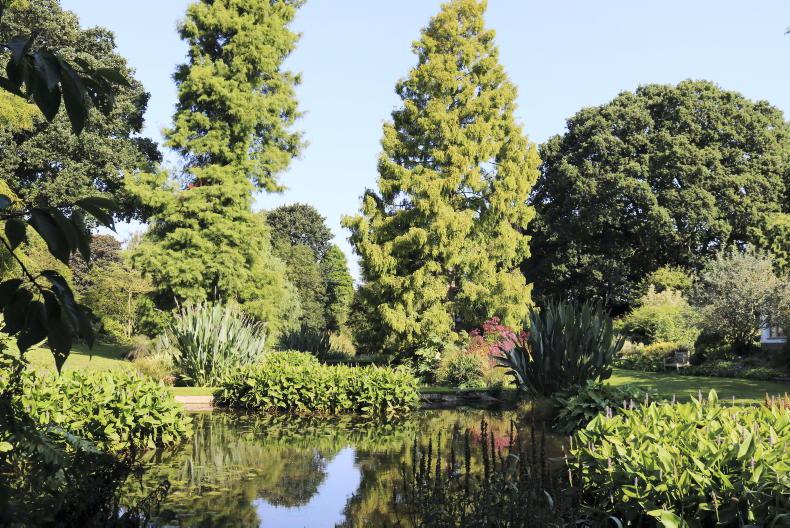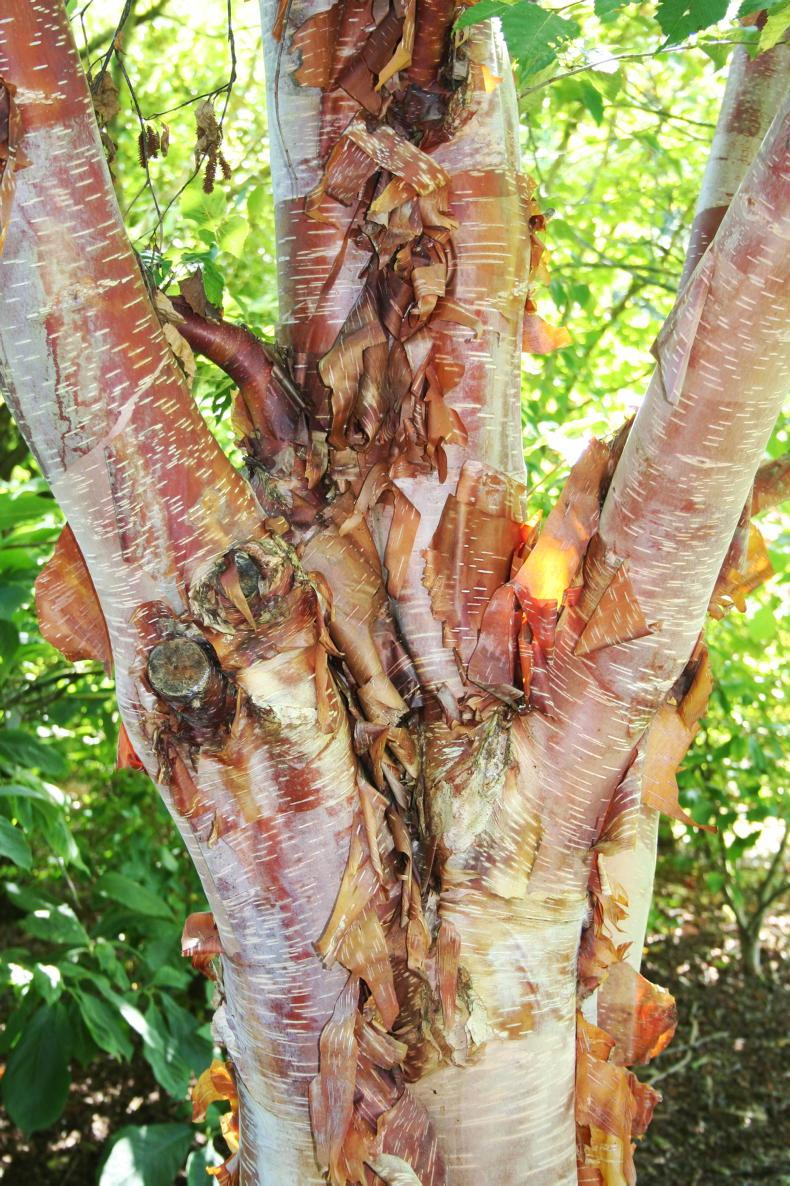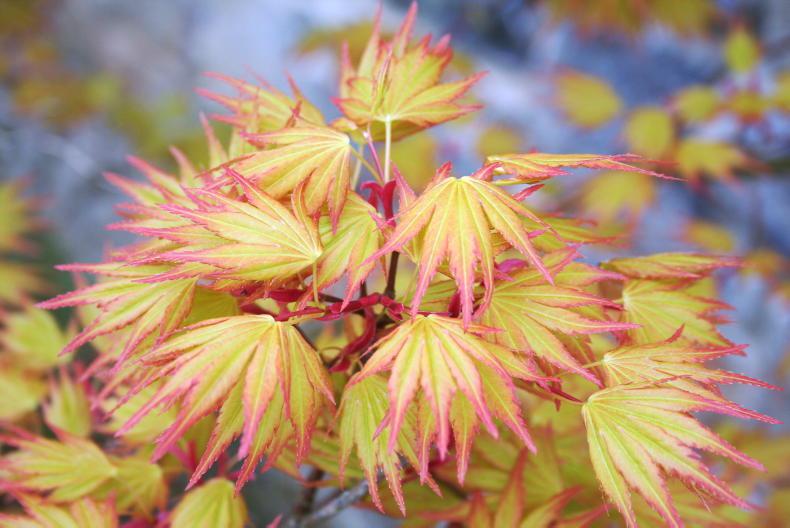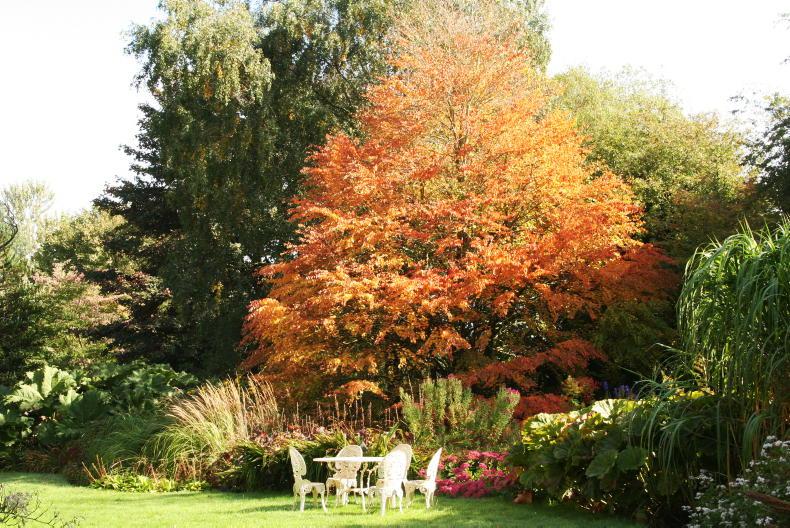The choice of tree species is dependent on its purpose, suitability to the local landscape character and the planting location. The first consideration is what you would like your tree to do.
If you’re looking for an ornamental specimen to grow in a large lawn or as a focal point, you might consider the handkerchief tree, Davidia involucrata, grown for the uniqueness of its dangling white bracts borne in May.

Although it often takes several years to commence flowering, the handkerchief tree, Davidia involucrata, is well worth the wait.
Another option is Parrotia persica which forms a wide-spreading, mushroom-shaped tree prized for its magnificent autumn tints and late winter flowers. To screen an ugly view, a group planting of silver birch, Betula pendula, can be very effective while hornbeam or lime trees are perfect for the formality of an avenue or linear planting.

Trees, with their varying forms and shapes, punctuate the skyline and provide structure in a garden or landscape setting.
Trees serve as the structure of a landscape setting and form the walls and ceilings that create outdoor spaces. They establish the permanent framework around which other elements of a garden or landscape are arranged and so their eventual size needs to ensure prominence.
What to consider
Properly placed trees can frame a view, mask unsightly features and provide a backdrop or setting for the home and garden. The mature height and width of a tree or groups of trees should be compatible with the scale and character of the space and surrounding buildings. Growing space both above and for the roots below ground must be considered. Using large-growing tree species with potential to grow old – like our native oaks, Quercus robur and our national tree Quercus petraea – will have much greater environmental benefits than small trees. Choosing trees with a shape or form that reflects the architectural lines or detailing of nearby built elements is a very effective way of achieving overall visual unity in a landscape setting. For example, trees with a strong pyramidal outline, like cedars, are a perfect complement to triangular roof lines while the horizontal branching of the flowering cherry Prunus ‘Shirotae’ harmonises well with flat-roof structures.
To provide background planting for an ornamental garden, maples, such as Acer rubrum ‘October Glory’ or the lovely Cercidiphyllum japonicum, whose leaves smell sweetly of burnt sugar in autumn, are good choices. These add a vertical layer that forms the skyline above shrubs and perennials.

Betula albosinensis 'Fascination' is valued especially in winter for its peeling bark featuring variations of orange, cream, brown and pink throughout.
Your choice of tree is also influenced by site conditions including soil type, drainage and degree of exposure. Most trees grow best in a moist, deep, fertile, well-drained soil. If you need something that will thrive in wet or poorly-drained soil, willows are a classic choice. With elegant, weeping boughs of bright yellow-green, the golden weeping willow, Salix x sepulcralis var. chrysocoma, makes a beautiful addition to a wet garden, provided it has enough space to grow. A much-underrated tree for damp conditions is ash look-alike Pterocarya fraxinifolia along with the pin oak, Quercus palustris.

Caucasia wingnut, Pterocarya fraxinifolia, merits greater use and is ideal for wet soils.
Both form large trees with the leaves of the latter turning brilliant red in autumn. If you’re looking for something a bit smaller, you may like the river birch, Betula nigra, with beautiful, reddish-brown, peeling bark.
Dry soil
For dry soil conditions and tolerance of drought, the Turkish hazel, Corylus colurna is a good choice. It matures to form a stately and imposing tree with a rough, corky bark that becomes more distinguished with age. The ornamental pear, Pyrus calleryana ‘Chanticleer’ is also a very tough and drought-resilient tree with a conical, upright crown and glossy, green leaves that turn reddish-purple in autumn.

Trees, with their varying forms and shapes, punctuate the skyline and provide structure in a garden or landscape setting.
On exposed and windy sites, our native hawthorn, cultivars of mountain ash, Sorbus aucuparia, and pine trees are amongst the most resilient. Coastal areas bring their own particular set of challenges where trees need to be wind resistant, tolerant to drought and impervious to salt. Almost all pines are suitable for coastal areas with Scot’s pine, Pinus sylvestris, being one of the most common. Other good candidates include the evergreen oak, Quercus ilex and Eucalyptus species.
Ornamental value is also a major consideration when choosing garden trees. While cherries are outstanding as flowering trees, there are others too including Japanese snowbell, Styrax japonica, whose fragrant, white flowers are best admired from underneath. Many trees produce decorative fruits while rich autumn leaf colour is a feature of aptly named Liquidamber styraciflua and most maples. Several trees are at their very best in winter when the full beauty of their bark can be appreciated.
For small gardens
When choosing trees for small gardens, try to choose something that will offer the most year-round value from your limited space. If you have room for just one tree, an ornamental crab apple, like Malus ‘Golden Hornet’, will offer pretty flowers in spring followed by colourful autumn fruits that persist well into winter. The delicately cut leaves of many Japanese maples such as Acer palmatum ‘Orange Dream’ change effects from spring through to autumn or opt for the classic beauty of a spring-blooming magnolia – pale pink-flowering Magnolia x loebneri ‘Leonard Messel’ is one of the most beautiful.

Acer palmatum ‘Orange Dream’ is a Japanese maple with striking leaf colouring from spring through to autumn.
If space is really restricted, you could plant Amelanchier alnifolia ‘Obelisk’ with white flowers in April and a densely branched, fastigiate growth habit or the aptly named flagpole cherry, Prunus ‘Amanagowa’ which also has a slender, columnar habit. In a small garden, upright-growing trees like these are very useful for drawing the eye upwards into the vertical dimensions of a space to help make a small space seem bigger.
So, whatever it is that you choose to plant, trees have a permanence that can span generations. When you plant one, it’s a symbol of your commitment to the environment and to the beauty of the world for future generations that, if well-chosen, will live on far beyond your own lifetime.
Read more
Remedial action on your lawn this spring
Laying the perfect lawn
The choice of tree species is dependent on its purpose, suitability to the local landscape character and the planting location. The first consideration is what you would like your tree to do.
If you’re looking for an ornamental specimen to grow in a large lawn or as a focal point, you might consider the handkerchief tree, Davidia involucrata, grown for the uniqueness of its dangling white bracts borne in May.

Although it often takes several years to commence flowering, the handkerchief tree, Davidia involucrata, is well worth the wait.
Another option is Parrotia persica which forms a wide-spreading, mushroom-shaped tree prized for its magnificent autumn tints and late winter flowers. To screen an ugly view, a group planting of silver birch, Betula pendula, can be very effective while hornbeam or lime trees are perfect for the formality of an avenue or linear planting.

Trees, with their varying forms and shapes, punctuate the skyline and provide structure in a garden or landscape setting.
Trees serve as the structure of a landscape setting and form the walls and ceilings that create outdoor spaces. They establish the permanent framework around which other elements of a garden or landscape are arranged and so their eventual size needs to ensure prominence.
What to consider
Properly placed trees can frame a view, mask unsightly features and provide a backdrop or setting for the home and garden. The mature height and width of a tree or groups of trees should be compatible with the scale and character of the space and surrounding buildings. Growing space both above and for the roots below ground must be considered. Using large-growing tree species with potential to grow old – like our native oaks, Quercus robur and our national tree Quercus petraea – will have much greater environmental benefits than small trees. Choosing trees with a shape or form that reflects the architectural lines or detailing of nearby built elements is a very effective way of achieving overall visual unity in a landscape setting. For example, trees with a strong pyramidal outline, like cedars, are a perfect complement to triangular roof lines while the horizontal branching of the flowering cherry Prunus ‘Shirotae’ harmonises well with flat-roof structures.
To provide background planting for an ornamental garden, maples, such as Acer rubrum ‘October Glory’ or the lovely Cercidiphyllum japonicum, whose leaves smell sweetly of burnt sugar in autumn, are good choices. These add a vertical layer that forms the skyline above shrubs and perennials.

Betula albosinensis 'Fascination' is valued especially in winter for its peeling bark featuring variations of orange, cream, brown and pink throughout.
Your choice of tree is also influenced by site conditions including soil type, drainage and degree of exposure. Most trees grow best in a moist, deep, fertile, well-drained soil. If you need something that will thrive in wet or poorly-drained soil, willows are a classic choice. With elegant, weeping boughs of bright yellow-green, the golden weeping willow, Salix x sepulcralis var. chrysocoma, makes a beautiful addition to a wet garden, provided it has enough space to grow. A much-underrated tree for damp conditions is ash look-alike Pterocarya fraxinifolia along with the pin oak, Quercus palustris.

Caucasia wingnut, Pterocarya fraxinifolia, merits greater use and is ideal for wet soils.
Both form large trees with the leaves of the latter turning brilliant red in autumn. If you’re looking for something a bit smaller, you may like the river birch, Betula nigra, with beautiful, reddish-brown, peeling bark.
Dry soil
For dry soil conditions and tolerance of drought, the Turkish hazel, Corylus colurna is a good choice. It matures to form a stately and imposing tree with a rough, corky bark that becomes more distinguished with age. The ornamental pear, Pyrus calleryana ‘Chanticleer’ is also a very tough and drought-resilient tree with a conical, upright crown and glossy, green leaves that turn reddish-purple in autumn.

Trees, with their varying forms and shapes, punctuate the skyline and provide structure in a garden or landscape setting.
On exposed and windy sites, our native hawthorn, cultivars of mountain ash, Sorbus aucuparia, and pine trees are amongst the most resilient. Coastal areas bring their own particular set of challenges where trees need to be wind resistant, tolerant to drought and impervious to salt. Almost all pines are suitable for coastal areas with Scot’s pine, Pinus sylvestris, being one of the most common. Other good candidates include the evergreen oak, Quercus ilex and Eucalyptus species.
Ornamental value is also a major consideration when choosing garden trees. While cherries are outstanding as flowering trees, there are others too including Japanese snowbell, Styrax japonica, whose fragrant, white flowers are best admired from underneath. Many trees produce decorative fruits while rich autumn leaf colour is a feature of aptly named Liquidamber styraciflua and most maples. Several trees are at their very best in winter when the full beauty of their bark can be appreciated.
For small gardens
When choosing trees for small gardens, try to choose something that will offer the most year-round value from your limited space. If you have room for just one tree, an ornamental crab apple, like Malus ‘Golden Hornet’, will offer pretty flowers in spring followed by colourful autumn fruits that persist well into winter. The delicately cut leaves of many Japanese maples such as Acer palmatum ‘Orange Dream’ change effects from spring through to autumn or opt for the classic beauty of a spring-blooming magnolia – pale pink-flowering Magnolia x loebneri ‘Leonard Messel’ is one of the most beautiful.

Acer palmatum ‘Orange Dream’ is a Japanese maple with striking leaf colouring from spring through to autumn.
If space is really restricted, you could plant Amelanchier alnifolia ‘Obelisk’ with white flowers in April and a densely branched, fastigiate growth habit or the aptly named flagpole cherry, Prunus ‘Amanagowa’ which also has a slender, columnar habit. In a small garden, upright-growing trees like these are very useful for drawing the eye upwards into the vertical dimensions of a space to help make a small space seem bigger.
So, whatever it is that you choose to plant, trees have a permanence that can span generations. When you plant one, it’s a symbol of your commitment to the environment and to the beauty of the world for future generations that, if well-chosen, will live on far beyond your own lifetime.
Read more
Remedial action on your lawn this spring
Laying the perfect lawn












 This is a subscriber-only article
This is a subscriber-only article










SHARING OPTIONS: